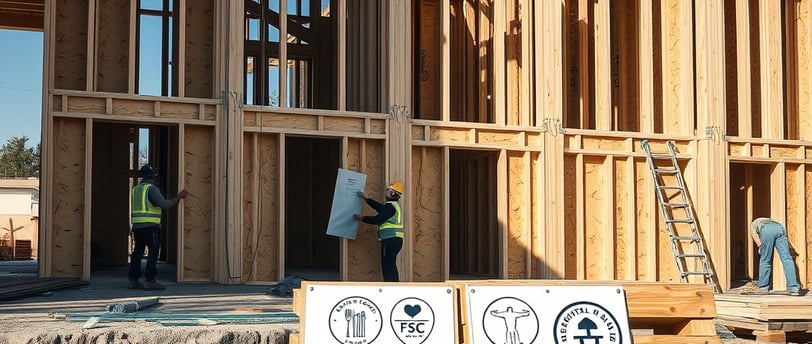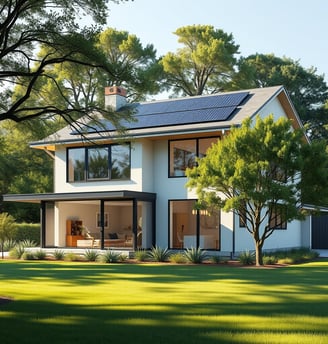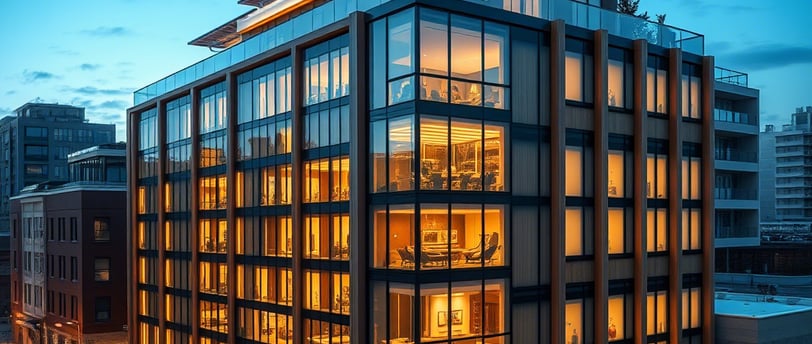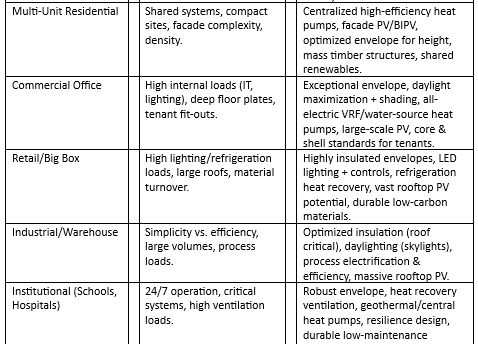Practical decarbonization strategies for architects net-zero projects.
The Architect’s Role in Net-Zero Construction
TSI BLOG
TSI Architects & Engineers
6/8/20255 min read


The climate crisis demands radical transformation within the built environment, responsible for nearly 40% of global energy-related CO2 emissions. Achieving net-zero carbon – balancing emissions released with those removed from the atmosphere – is no longer a niche aspiration but an urgent necessity. At the heart of this transformation stands the architect. No longer solely the designer of form and function, the architect is now the essential integrator, advocate, and climate steward, guiding projects towards true decarbonization across all typologies, from single-family homes to sprawling urban complexes. This guide outlines the practical strategies architects must employ to fulfill this critical role.
Reframing the Role: From Aesthetic Custodian to Climate Steward
The architect's traditional focus on aesthetics, program, and budget remains vital, but it must now be fundamentally interwoven with carbon accountability. This shift demands:
Systems Thinking: Understanding buildings as interconnected systems within larger ecological and energy grids.
Lifecycle Perspective: Considering impacts from material extraction (cradle) through construction, operation, and end-of-life (grave), not just operational energy.
Performance-Driven Design: Prioritizing measurable environmental outcomes (energy use intensity, embodied carbon, indoor air quality) alongside spatial and experiential goals.
Collaborative Leadership: Championing early and deep collaboration with clients, engineers, contractors, cost consultants, and sustainability specialists.
Core Decarbonization Pillars: The Architect's Toolkit
Decarbonization strategies rest on several interdependent pillars, applicable across all project types:
Radical Energy Efficiency (The Foundation):
Passive Design First: Exploiting site, climate, and natural forces. Optimize orientation, compact form, high-performance envelope (insulation, air-tightness, thermal bridging elimination), strategic shading, and natural ventilation. This reduces the need for energy before systems are considered.
Fabric-First Approach: Invest in the building shell – superior insulation, triple-glazed windows, meticulous detailing – for long-term, low-maintenance energy savings.
Load Reduction: Minimize internal gains through efficient lighting and appliances (specify high-efficiency!), and consider occupant behavior in design (e.g., intuitive controls).
Electrification & Renewable Energy Integration:
All-Electric Systems: Phase out fossil fuels (natural gas, oil, propane) for heating, cooling, cooking, and hot water. Specify high-efficiency electric heat pumps (air-source, ground-source), induction cooktops, and heat pump water heaters.
On-Site Renewables: Maximize viable on-site generation – roof-mounted PV, building-integrated PV (BIPV), solar thermal. Architecturally integrate renewables aesthetically and functionally from the outset.
Off-Site Renewables: When on-site generation is insufficient (high-rises, dense urban sites, retrofits), facilitate procurement of 100% renewable energy via Power Purchase Agreements (PPAs) or certified green tariffs. Design for future grid integration and storage.
Embodied Carbon Reduction (The Critical Frontier):
Material Selection: Prioritize low-carbon materials: timber (especially mass timber where structurally viable), bamboo, low-carbon concrete mixes (SCMs, optimized mixes), recycled metals (steel, aluminum), natural insulations (cellulose, wood fiber), and reclaimed/recycled content materials. Utilize Environmental Product Declarations (EPDs).
Design for Less Material: Optimize structural efficiency, design for disassembly/reuse, specify materials with high recycled content, avoid over-specification, and embrace adaptive reuse of existing structures.
Low-Carbon Construction: Advocate for low-emission construction practices (electric equipment), efficient logistics, and waste minimization strategies.


Resilience & Adaptation:
Future-Proofing: Design for changing climate conditions (extreme heat, precipitation, storms). Incorporate passive survivability (maintaining safe conditions during power outages).
Water Efficiency: Reduce demand (low-flow fixtures), capture and reuse rainwater/greywater, and manage stormwater sustainably (bioswales, green roofs) to reduce energy-intensive water treatment.
Practical Implementation Across Project Phases
The architect's decarbonization role evolves throughout the project lifecycle:
Pre-Design & Briefing:
Set Ambitious Goals: Champion net-zero carbon (operational and/or whole-life) as a core project objective from day one. Educate clients on benefits (resilience, value, occupant health, compliance).
Site Analysis: Conduct deep site analysis for passive solar, wind, shading opportunities, renewable potential, and existing structures suitable for reuse.
Establish Metrics: Define key performance indicators (KPIs) early: pEUI (predicted Energy Use Intensity), embodied carbon (kgCO2e/m²), renewable energy coverage, airtightness targets.
Concept & Schematic Design:
Massing & Orientation: Optimize building form and orientation for solar gain (heating season), shading (cooling season), and natural ventilation.
Envelope Definition: Establish high-performance envelope specifications – U-values, glazing ratios, thermal bridging strategy, air-tightness target.
Passive Systems Integration: Design shading devices, thermal mass placement, and natural ventilation pathways.
Early LCA: Conduct simplified Life Cycle Assessment (LCA) to compare major material/system choices and identify high-impact reduction opportunities.
Renewable Energy Strategy: Integrate PV/solar thermal potential into massing and roof design.
Design Development:
Detailed Envelope Design: Resolve complex junctions to eliminate thermal bridges. Specify exact insulation types and thicknesses, window specs, and air barrier systems.
System Selection & Integration: Finalize all-electric HVAC systems (heat pumps, ERVs/HRVs), hot water, and lighting. Ensure systems are sized correctly based on highly efficient loads.
Material Specification: Select specific low-carbon materials based on EPDs and LCA results. Prioritize locally sourced materials where feasible to reduce transport emissions.
Refined Energy Modeling: Use detailed energy models to predict performance, optimize systems, and ensure net-zero operational energy feasibility.
Embodied Carbon Calculation: Perform more detailed LCA to track progress and identify further reduction levers.
Construction Documentation:
Clear Specifications: Precisely document low-carbon materials, air-tightness requirements, insulation installation protocols, and renewable system details. Avoid substitution with high-carbon alternatives.
Robust Detailing: Provide construction details that ensure thermal continuity and air barrier integrity are achievable on site.
Commissioning Requirements: Specify rigorous commissioning procedures for building envelope and MEP systems to ensure they perform as designed.


Bidding & Construction:
Contractor Engagement: Facilitate pre-bid meetings to emphasize net-zero goals and critical details (airtightness, insulation continuity). Select contractors with relevant experience or commitment.
Site Oversight: Monitor key decarbonization aspects: proper installation of insulation and air barriers, handling of low-carbon materials, and adherence to waste management plans. Conduct interim air-tightness testing.
Problem Solving: Address unforeseen site conditions with solutions that maintain or improve decarbonization goals.
Operation & Post-Occupancy:
Handover & Training: Provide comprehensive building user guides focusing on efficient operation of systems. Train facilities management.
Monitoring & Verification: Advocate for (or design-in) energy monitoring systems. Pursue certification (LEED Zero, ILFI Zero Carbon, BREEAM Outstanding) requiring performance verification.
Feedback Loop: Use post-occupancy evaluation data (energy use, occupant comfort) to inform future designs and refine strategies.
Decarbonization Levers by Project Type: A Practical Snapshot.


Overcoming Challenges & Seizing Opportunities
Cost Perception: Frame net-zero as an investment with rapidly improving ROI due to energy savings, rising carbon costs/taxes, increased asset value, and occupant health benefits. Advocate for lifecycle cost analysis (LCCA).
Regulatory Gaps: Lead by example. Advocate for progressive building codes and policies (electrification mandates, embodied carbon limits). Utilize voluntary certifications (LEED, BREEAM, LBC) to push boundaries.
Skills & Knowledge: Commit to continuous learning on LCA tools, evolving materials, energy modeling, and building science. Foster collaboration with specialist consultants.


Supply Chain: Specify demand for low-carbon materials. Engage with suppliers early. Support transparency (EPDs).
Client Hesitation: Communicate the value proposition clearly: future-proofing against energy price volatility and carbon regulation, enhanced occupant health/productivity/attraction, brand leadership, and resilience.
Conclusion: The Imperative Leadership Role
Achieving net-zero across the built environment is an immense challenge, but it is achievable with architects at the helm. By embracing their expanded role as climate stewards, mastering decarbonization strategies across all project phases and types, and leading through collaboration and advocacy, architects have the unique power to transform the industry. This practical guide provides the framework – the tools, the mindset, and the focus areas – but the execution requires unwavering commitment, innovation, and the courage to prioritize planetary health in every design decision. The path to net-zero is complex, but it is the only viable path forward, and the architect is the indispensable guide. The time for practical, decisive action is now. Let the design of a sustainable future begin on the drafting table, in the energy model, and on the construction site, led by architects equipped with knowledge, passion, and a profound sense of responsibility.
TSI Architects & Engineers
© 2024. All rights reserved.
